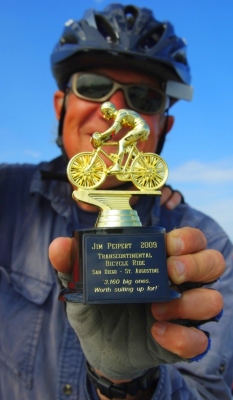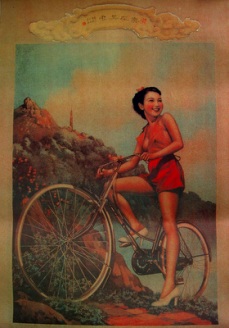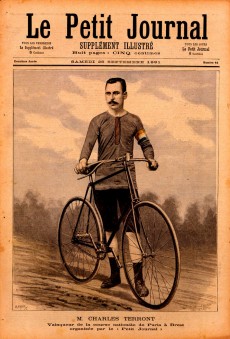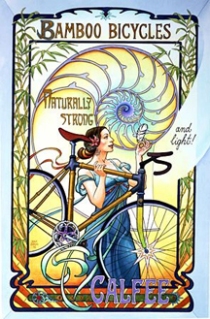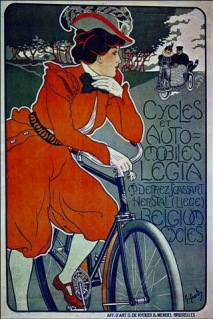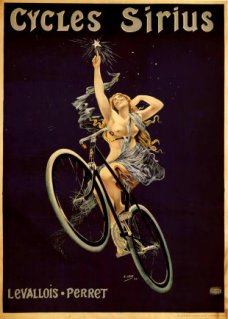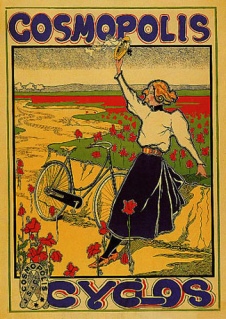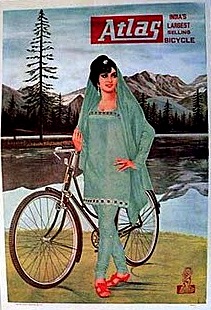 Despite the economic tumult, 2009 has been a pretty good year. It was the first full year of my retirement, which allowed me to fulfill a long-held dream: to ride my bicycle across the United States.
Despite the economic tumult, 2009 has been a pretty good year. It was the first full year of my retirement, which allowed me to fulfill a long-held dream: to ride my bicycle across the United States.
As followers of this blog know, the journey was accomplished this fall — Sept. 20 to Nov. 21, from San Diego to St. Augustine, Fla.
So to all the special people I rode with along the southern tier of the United States, to the many kind and helpful folks we met along the way, and to all the relatives, friends and other well-wishers who shared the adventure vicariously through this blog: Merry Christmas and a Happy New Year.
Now to decide on an adventure for 2010!
Monthly Archives: December 2009
Merry Christmas to all …
Filed under Cycling across America, Journeys
At the risk of terminal boredom …
 One of the most dreaded questions in the English language is: Would you like to see my vacation photos?
One of the most dreaded questions in the English language is: Would you like to see my vacation photos?
It ranks right up there with such questions from a wife as: Would you like to go with me to the fabric shop? Or: Why don’t we clean out the garage?
So at the risk of inflicting terminal boredom, I’m posting a yet another selection of photos from the transcontinental bicycle journey that I rode in this fall.
Nearly all of our original party of 15 carried cameras to chronicle the journey from San Diego to St. Augustine, Fla. I’ve already posted several selections of my photos. Other participants have now started posting their photos on a Web site that we can all look at.
Here are some photos by John Diller and Mike Ullner:

On the climb from Three Way, Ariz., toward New Mexico. From left Derrik, Kami, Gerben (Kevin), Reg, Cathy and Jim. Photo by John Diller

At Gila Cliff Dwellings National Monument in New Mexico. From left Gerben (Kevin), Mike, Jim, a volunteer guide, Reg, Dolores, Derrik and Kami. Photo by John Diller

At Emory Pass in New Mexico. From left Reg, Cathy Jim, John (sitting), Gerben (Kevin) Derrik and Dave. Photo by John Diller

Leaving Austin after two rest days. From left Mary Ellen, Derrik, Jim, Cathy and Erik. Photo by John Diller

Dinner at Bastrop State Park in Texas. From Left Cathy, Jim, Gerben and Derrik. Photo by Mike Ullner

Group photo in Merryville, La. From left John D., Gerben (Kevin), Jenny, Felix, Cathy, Dave, Mike, Dolores, Derrik, Kami, Jim, Reg and John V.

At an RV park in East Palatka, Fla., our last night on the road. From left Dolores, Gerben (Kevin) and Jim. Photo by John Diller
Filed under Americana, Cycling across America, Journeys
Learning from my sons
“Most people don’t take snapshots of the little things. The used Band-Aid, the guy at the gas station, the wasp on the Jell-O. But these are the things that make up the true picture of our lives. People don’t take pictures of these things.”
— Sy Parrish (Robin Williams), One Hour Photo, 2002
Two of our sons, gifted photographers, have an eye for shooting compelling pictures of the quirky and bizarre, and the commonplace objects of everyday life.
I’m sometimes too burdened by the habits of conventional photography: Sticking mostly to landscapes and portraits, straightening the image in the viewfinder, trying to include everything that tells the story. But that sometimes makes for boring photos, the sort you see on postcards.
America’s highways and byways are littered with the quirky and bizarre, such as a statue of a giant rooster welcoming tourists to Hatch, N.M., old boots used as fence post toppers in the Texas Hill Country, or the poignant photos of lost loved ones at a roadside shrine near Miami, Ariz.
I’ve been trying to learn from my sons how to spot such curiosities and make them into engaging photographs. Here’s a selection of odds-and-ends photos — images that caught my eye — during a transcontinental bicycle ride:
Filed under Americana, Cycling across America, Journeys
Majestic landscapes of the Borderlands
“It opens the lands that have lured the people from the beginning of time.”
— From a 1923 travelogue on the Old Spanish Trail, called the “the highway of the Southern Borderlands”
Traveled by conquistadors and padres, traders and soldiers, and now by transcontinental cyclists and snowbirds in big, honkin’ motor homes, the Old Spanish Trail connects San Diego in California with St. Augustine in Florida along the southern edge of the United States.
 In its progress of more than 3,000 miles through a region called the Borderlands, the highway affords some of the most spectacular and varied terrain in North America — searing deserts with wind-swept dunes in California, rugged mountains adorned with saguaro cacti or ponderosa pine, undulating grasslands, cyprus trees towering beside spring-fed rivers in the Texas Hill Country, white sand beaches on the Gulf of Mexico and live oaks draped with Spanish moss amid the swamps and bayous of the Deep South.
In its progress of more than 3,000 miles through a region called the Borderlands, the highway affords some of the most spectacular and varied terrain in North America — searing deserts with wind-swept dunes in California, rugged mountains adorned with saguaro cacti or ponderosa pine, undulating grasslands, cyprus trees towering beside spring-fed rivers in the Texas Hill Country, white sand beaches on the Gulf of Mexico and live oaks draped with Spanish moss amid the swamps and bayous of the Deep South.
Our cross-country bicycle caravan traveled a route that roughly tracked the Old Spanish Trail, from San Diego — through such cities and towns as Phoenix and Las Cruces, El Paso and Van Horn, Fort Stockton and Comfort, Ocean Springs and Mobile, Pensacola and DeFuniak Springs — to St. Augustine.
The progenitor of today’s Interstate 10, the Old Spanish Trail was the most southerly coast-to-coast route developed in the early days of the automobile. It roughly follows what later became U.S. 90 in the east and U.S. 80 in the west.
 The Old Spanish Trail was launched in 1915 in Mobile, Ala., as a connector route between New Orleans and Florida and worked on in fits and starts — including an interruption by World War I — until its completion in 1929. With its midway point in San Antonio, Texas, the Old Spanish Trail crosses 67 counties and eight states along the Southern border of the United States.
The Old Spanish Trail was launched in 1915 in Mobile, Ala., as a connector route between New Orleans and Florida and worked on in fits and starts — including an interruption by World War I — until its completion in 1929. With its midway point in San Antonio, Texas, the Old Spanish Trail crosses 67 counties and eight states along the Southern border of the United States.
“Along the Old Spanish Trail are the riches of history, legend, sentiment and natural beauty,” said a description from The Rand McNally Automobile Road Book of 1923. “And throughout the route there are members of the Old Spanish Trail Association who will find pleasure in making your acquaintance.”
They may not have been members of the Old Spanish Trail Association, but plenty of friendly people made our acquaintance as we traveled the Southern Tier route from Sept. 20 to Nov. 21, absorbing some of the history and wondering at the majestic terrain.
Here’s a selection of photographs of sights along the southern edge of America:
Filed under Americana, Cycling across America, Journeys, Texana
Random snappies from the road
“Photography as a fad is well-nigh on its last legs, thanks principally to the bicycle craze.”
— Alfred Stieglitz, American photographer, 1864-1946
I frequently try to add a touch of erudition to these sometimes prosaic jottings about bicycling, journeys, writing and other trivia by affixing a germane quote at the top of a blog post.
That prompted an hour or two of research to try to figure out what Stieglitz meant. It was a wet, raw, dreary morning in Fort Worth — too nasty for any outdoor activity except the obligatory dog walk. So the research was a rainy-day pleasure.
The findings: In the 1880s, innovations in plate technology led to development of hand-held cameras, which made photography available to nearly everyone. Like bicycling, the snapping of candid photographs — unposed and unretouched — became the latest fad.
In 1888, George Eastman marketed his Kodak camera with the slogan: “You press the button,and we do the rest.”
Stieglitz apparently had trouble reconciling himself to these rapid changes in his chosen craft. Here’s the full quote, from an 1897 essay “The Hand Camera — Its Present Importance,” in The American Annual of Photography:
“Photography as a fad is well-nigh on its last legs, thanks principally to the bicycle craze. Those seriously interested in its advancement do not look upon this state of affairs as a misfortune, but as a disguised blessing, inasmuch as photography had been classed as a sport by nearly all of those who deserted its ranks and fled to the present idol, the bicycle.
“The only persons who seem to look upon this turn of affairs as entirely unwelcome are those engaged in manufacturing and selling photographic goods.
“It was, undoubtedly, due to the hand camera that photography became so generally popular a few years ago. Every Tom, Dick and Harry could, without trouble, learn how to get something or other on a sensitive plate, and this is what the public wanted — no work and lots of fun. Thanks to the efforts of these persons hand camera and bad work became synonymous.
“The climax was reached when an enterprising firm flooded the market with a very ingenious hand camera and the announcement, ‘You press the button, and we do the rest.’
This was the beginning of the ‘photographing-by-the-yard’ era, and the ranks of enthusiastic Button Pressers were enlarged to enormous dimensions. The hand camera ruled supreme.
“Originally known under the odious name of ‘Detective,’ necessarily insinuating the owner to be somewhat of a sneak, the hand camera was in very bad repute with all the champions of the tripod. They looked upon the small instrument, innocent enough in itself, but terrible in the hands of the unknowing, as a mere toy, good for the purposes of the globe-trotter, who wished to jot down photographic notes as he passed along his journey, but in no way adapted to the wants of him whose aim it is to do serious work.
“But in the past year or two all this has been changed. There are many who claim that for just the most serious work the hand camera is not only excellently adapted, but that without it the pictorial photographer is sadly handicapped.”
Stieglitz came to embrace the portability of the hand camera and used it in the 1890s to shoot some of his best known photographs.
I wonder what he would have made of the digital images produced by today’s point-and-shoot cameras and their proliferation on such networking sites as Facebook and Twitter and in the blogosphere.
 I’ve found that retirement affords one the time to engage in these pursuits of arcane knowledge.
I’ve found that retirement affords one the time to engage in these pursuits of arcane knowledge.In any case, here’s a selection of images made by today’s equivalent of the 1888 Kodachrome — a Canon PowerShot SD1100 IS — of fellow participants in the cross-country bicycle trip, which began in San Diego on Sept. 20 and ended in St. Augustine, Fla., on Nov. 21, the Saturday before Thanksgiving.
Filed under Americana, Cycling across America, Journeys
A tribute to a tire
“[T]he best touring tire in the world.”
— Round-the-world cyclist Scott Stoll
 I’ve been asked several times since completing a transcontinental bicycle trip: How many tires did you go through?
I’ve been asked several times since completing a transcontinental bicycle trip: How many tires did you go through?
Tires, after all, are perhaps the most vulnerable part of a bicycle — especially a touring cycle loaded down with about 55 pounds of gear. The tires are in constant contact with the road and all its hazards: shards of glass, nails, sharp bits of metal and those West Texas beasties called goatheads: rock-hard, little burrs sloughed off by a ground-hugging plant with small leaves and yellow flowers called Tribulus terrestris.
 But in answer to the question: I finished the journey of more than 3,100 miles from San Diego to St. Augustine, Fla., with the same set of tires: German-made Schwalbe Marathon Plus touring tires. And if not for a freak mishap involving my rear rack, I would have finished the trip without a flat.
But in answer to the question: I finished the journey of more than 3,100 miles from San Diego to St. Augustine, Fla., with the same set of tires: German-made Schwalbe Marathon Plus touring tires. And if not for a freak mishap involving my rear rack, I would have finished the trip without a flat.
Some riders in our caravan of 15 — pared to 12 by the end — had so many flats that they lost count. One rider had four flats in a single day.
A good example of flat-prone tires was our Oct. 9 ride out of Las Cruces, N.M. A local cyclist had suggested we use a bike trail along the Rio Grande to avoid heavy rush-hour traffic on U.S. 70.
It seemed like a good idea at the time, but the trail was infested with goatheads.
Six of us rode the trail. At the end, our tires were festooned with the burrs, which caused a total of seven flat tires. One rider, using a small-wheeled Bike Friday and pulling a two-wheeled trailer, had three flats. Another had two. And two others had one each.
The tires again proved their worth near Van Horn in West Texas on Oct. 11. About three miles out of Van Horn, our intended destination, I heard something banging on my bike frame with each rotation of the rear wheel. I thought I had broken a spoke, in which case I would have been in deep doo-doo because I’ve never replaced a spoke and didn’t have the tools to do it even if I knew how.
But the noise turned out to be a nail of about 2 1/2 inches that had penetrated my rear tire at an angle. I thought the tire would immediately go flat once I worked out the nail. But, wonder of wonders, when I extracted the nail the tire remained hard and fully inflated. The nail apparently penetrated only the protective rubber cushion on the Marathon Plus tire and didn’t reach the tube.
If it had, I’m not sure that my self-sealing tubes would have prevented a flat. So I credit the tire.
A Sept. 15 post on the blog GearJunkie told the story of Scott Stoll, who has bicycled around the world and is now circumnavigating North America. The blog post discussed the gear that Stoll is using and quoted him as saying that the Schwalbe Marathon Plus, which has a 5mm-thick layer of rubber for puncture protection, is “the best touring tire in the world.”
I’d second that.
“The Marathon Plus tires, which cost $55 a piece,” the blog said, “are cited by the company as impenetrable even by shards of glass and thumbtacks. Stoll went 15,000 miles on one set.”
Several members of our group tried to find Specialized Airlock tubes at bike shops along our route. One rider, who had several flats, called his bike shop in Los Angeles and had a set of Marathon Plus tires sent to Del Rio, Texas, one of our overnight stops.
The one time that I had to change a tire was during the last week of the ride on Nov. 16 in the Florida Panhandle. After nearly two months on the road and more than 2,800 miles of riding since leaving San Diego on Sept. 20, I was the only one in our company who had not had a flat.
But my flat-free record was broken not by a failing of my tires, but by loose screws on my rear rack. All of the screws that secured the rear rack to my bicycle frame had worked loose because of the jolts and jostles of a transcontinental bicycle journey.
As I was riding along a quiet country road just west of Woodville, Fla., I came to a screeching halt.
The rear rack had separated from the brackets that secure it to the frame just behind the seat post. The rack rotated backward on the bottom bolts at the rear axle and dropped the rear panniers to the pavement. They dragged behind the bike like an anchor.
A loose bracket that had held the rack in place behind the seat post dropped down and stabbed the rear tire as it rotated forward. Like a knife, it penetrated the cushion that protects against run-of-the-mill punctures: nails, thorns, wire-like pieces of steel from truck tires.
I had to dismount the panniers, resecure the rack and replace one of the flimsier bolts with a good stout one. The tire had a small stab wound, and the tube had a slash too large to repair. But I was carrying three spare tubes.
So I was delayed only about 45 minutes and rode flat-free the rest of the week to St. Augustine, our final destination, which we reached Nov. 21.
On any future tours, I’ll plan to use Schwalbe Marathon Plus tires.
Filed under Cycling across America, Journeys
Another journey ends
“So many of our dreams at first seem impossible, then they seem improbable, and then when we summon the will, they soon become inevitable.”
— Christopher Reeve, American actor, 1952-2004
Neal set out from Lake Itasca, the source of the Mississippi in northern Minnesota, on July 10 and arrived on Tuesday evening in New Orleans — a journey of four months and 22 days.
From Neal’s Dec. 1 post: “Fought severe weather today to guide the Andrea safely into New Orleans. Wind and waves and rain and a plethora of barges and tankers as well as borderline hypothermia couldn’t keep me from this fine town. About to join up with friends here locally — gonna be great. My sincere thanks to everyone — could not have made it without your encouragement and support. More to follow …”

Fellow rider John Vandevelde talks to a curious ferry passenger as we cross the Mississippi. That's my bike in the foreground
I thought of Neal that day as I and fellow rider John Vandevelde waited at the ferry landing to cross the river to St. Francisville. The Mississippi, probably a mile wide at that point, was running high and fast, and two men in a canoe were riding the swift current downriver. Their craft seemed so frail on that mighty, mercurial river.
So hats off to Neal for completing an epic journey! Few people get to live their dreams.
Here’s Neal’s latest video post, some random video footage shot on his way down the Mississippi.
Filed under Americana, Cycling across America, Journeys
The dipping of the wheels
“The best laid schemes o’ mice an’ men,
Gang aft agley…”
— Robert Burns, “To A Mouse,” 1785
It’s customary at the end of a transcontinental bicycle ride to dip the front wheels into the opposite ocean.
We started the journey by baptizing the wheels in the Pacific at Ocean Beach in San Diego on Sept. 20 and ended it with a wheel-dipping in the Atlantic Ocean in St. Augustine, Fla., on Nov. 21, the Saturday before Thanksgiving.
This latest batch of photos is being posted more than a week after the event because they were shot by our youngest son, Thomas, and I had neglected to transfer the photos from his camera to my computer. So he had to e-mail them to me from Denver.
I had taken a shorter route to St. Augustine on the last day of our trip to make sure that I could pick up my rental car before the Budget location closed at 4 p.m. that Saturday. It turns out that the Budget office, on U.S. 1, is inside a Super Wal-Mart.
I had originally planned to ride to the Pirate Haus Inn, where our bike group was to stay that night, drop all my gear and then ride to a designated rendezvous point, meet my fellow riders and then head to the beach. But my route into St. Augustine on Florida 207 intersected with U.S. 1, only about a mile from the rental car location.
So I rode instead to the Budget office, picked up my rental car, loaded my bike and gear and then bought a pair of jeans at Wal-Mart because I was tired of wearing the same set of clothes for more than two months.
Lo and behold, as I was leaving the store, Mary Ellen, Matt and Thomas were walking in. They were headed for the Budget office to tell the staff NOT to rent me a car because they already had rented one at the airport in Jacksonville.
With two rental cars on our hands, we had to get rid of one of them, which took about an hour. We then drove to the Pirate Haus, where Mary Ellen and the boys had stayed the previous night, and unloaded my gear. I then rode to the rendezvous point at the Bridge of Lions, met my compadres, and we rode to the beach as a triumphant group.
Mary Ellen and the boys, meanwhile, drove to the beach and were on hand with other relatives and friends of the riders to greet us with signs, cow bells and pompoms. We all then went to the beach for the ritual baptism of the wheels and these photographs.
It was a suitable finish to a great ride.
Filed under Cycling across America, Journeys




























































































